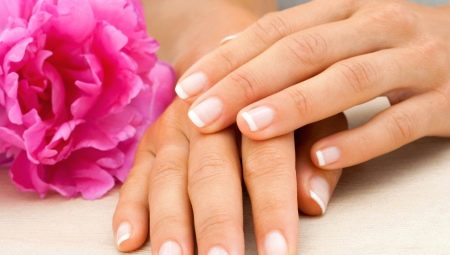French manicure is today considered one of the classic types of design. Due to its versatility, it will always remain on the crest of a wave. Therefore, those who are still unfamiliar with the implementation of this design using modern coatings should get acquainted with the features of the design itself and learn the step-by-step technique for its implementation.
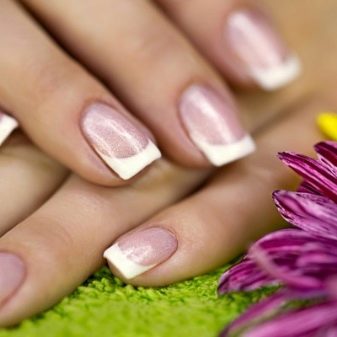
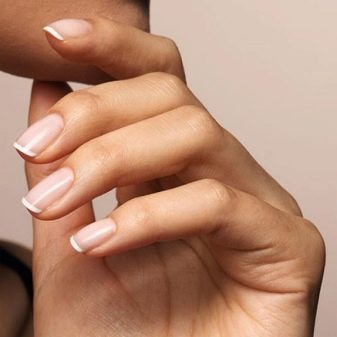
Features
French, French manicure or French design - all these are the names of a single type of nail design. It appeared far from France, but in America, today the technology has already turned 40 years old. The idea of its creation was born due to the lack of time for painting the nails of actresses. That is why a design was needed that would fit any image, which was created by the founder of the Orly Trading House.
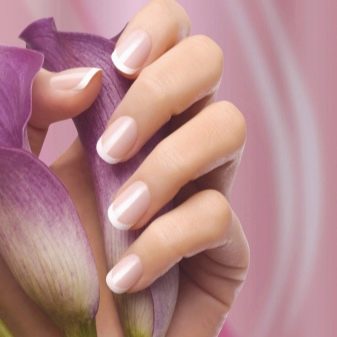

The classic version of the jacket has a flesh-colored background and a white smile, which decorates part of the overgrown nail.
Today, this trend is quite relevant in situations of strict dress code. The very same French has long gone beyond the classics: the focus of fashion trends is color solutions, as well as nail decoration with a smile. The smile shape of a traditional French manicure can be different.
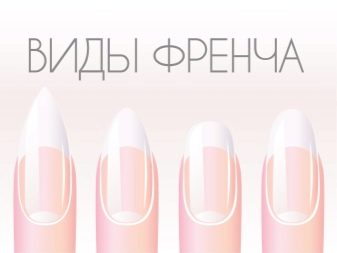
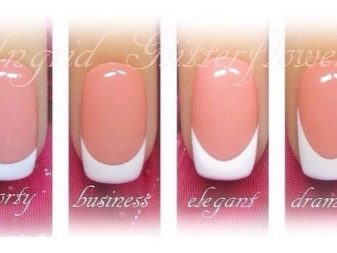
It depends on the characteristics of the nail plate, as well as on the shape of the saw overgrown edge. The width of the contrast strip can vary, sometimes it is very thin, in other cases it is completely diagonal. For example, in nails of an amygdala shape, the smile is wider in comparison with the nails of the oval shape. And today, a smile can also be fantasy, which opens up a lot of opportunities for creating a thematic and seasonal design.
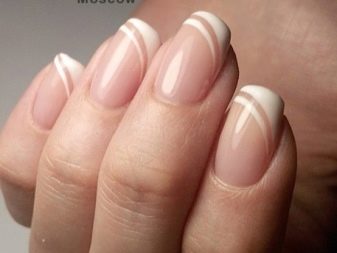
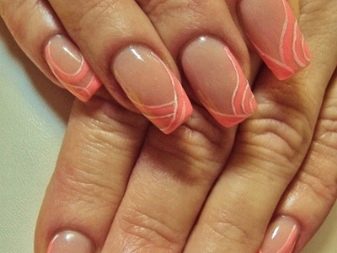
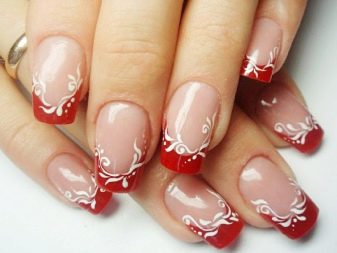

The inverted jacket differs from the usual one in that, in fact, is its mirror image. That is, his smile is located at the base of the nail bed. Such a manicure today is considered one of the most popular. It is used by beauty bloggers and celebrities.
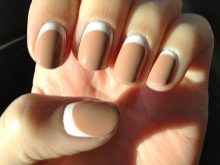
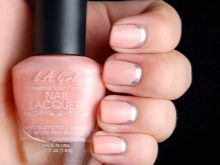
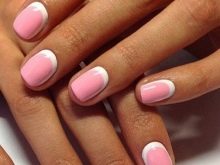
The shape of such a smile can be very diverse. For example, in addition to the hole and simulating the growth of the nail plate, it can be diagonal, triangular, semicircular and made as a contour stroke. One of the features of the modern jacket is its combination with all the well-known manicure techniques. Moreover, it can be the basis or its accents. Plates with a contrasting smile can be decorated with different nail materials.
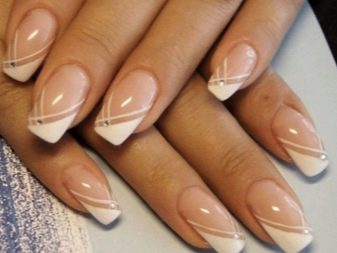
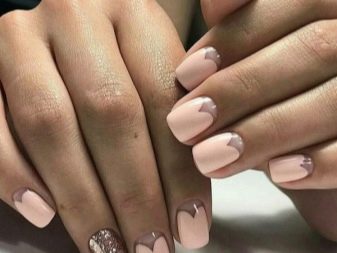
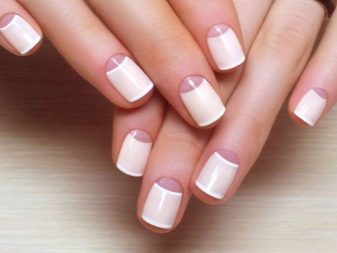
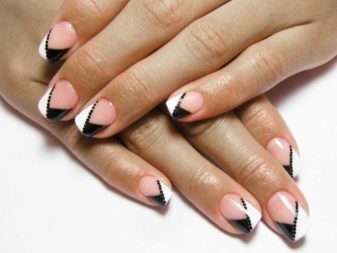
Ways to apply a "smile"
You can make a smile in many ways. For beginners who are just beginning to master the work with gel polish, it is worth considering the fact that due to the particular composition it is possible to work without haste. Hybrid coatings that French manicure today do not dry without a special lamp. Therefore, you can safely engage in design and adjust it before drying in a UV or LED device. As for the methods of applying the so-called smile, they depend on the design. In general, for beginners, the option of using auxiliary strips or foil tape is better. The main nuances of different options can be divided into traditional (brush and stripes) and fantasy (stamps, dots, stickers, fimo).
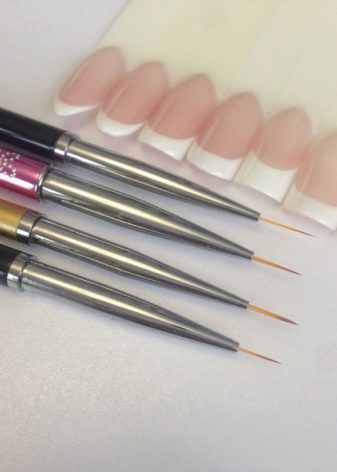
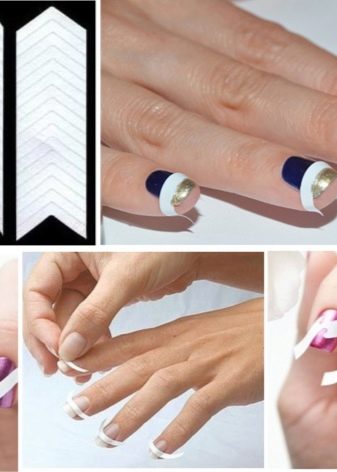
Brush
Using manicure brushes to form a French smile can be difficult for beginners. It is difficult to evenly draw lines on all fingers to make the design look professional. Of course, you can contrive and resort to fantasy drawings, but if there are no drawing skills, such a manicure will not look beautiful. To learn how to draw the necessary lines, and even more so drawing yourself, it is worth practicing on special stencils.

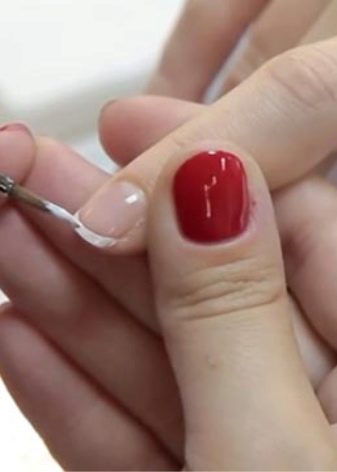
Stencils
French stencils mean special strips of different shapes and widths. Depending on the client’s desire, you can use both traditional arched elements, as well as corners, waves, zigzags, hearts. However, stencils do not simplify the work by 100%, as beginners might mistakenly think. Together with them, when separating from the base, a part of the varnish that created a smile can depart. And this means that you can’t do without a brush, because you will have to correct the lines.
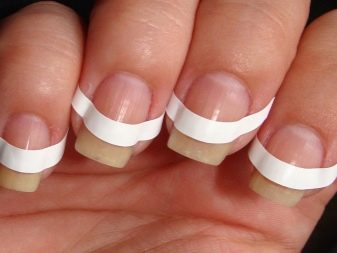
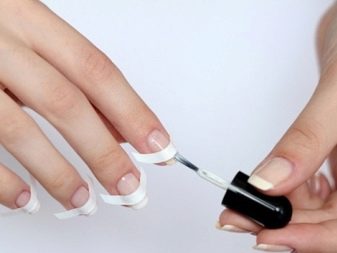
Dots
Sets of sticks with different nozzles allow you to create one of the most popular french designs today. At the ends of the tools are metal balls that are dipped in gel polish, and then put points on the nail plate in the right places. It’s easy to work with such a tool, but at least without a minimal training, you won’t be able to make a beautiful smile. In addition to the fact that you need to clearly set the points on the selected form, which should be perfectly identical on the other nails of the jacket, you need to make points of different sizes.
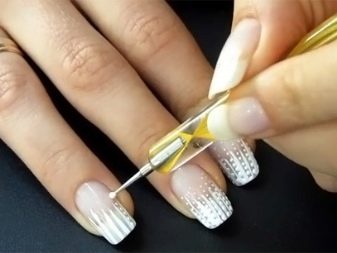
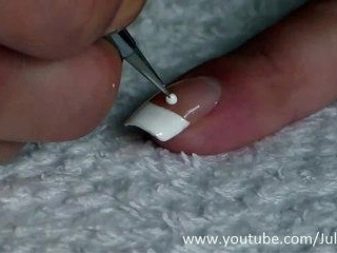
Stamping
This method is easy, because working with stamps having an engraved pattern will work perfectly the first time. Stamping is distinguished by the accuracy of the lines, for which masters of nail service choose this type of design. Like the previous version, this type of smile turns out to be fancy. It is also applied to accent manicure nails.
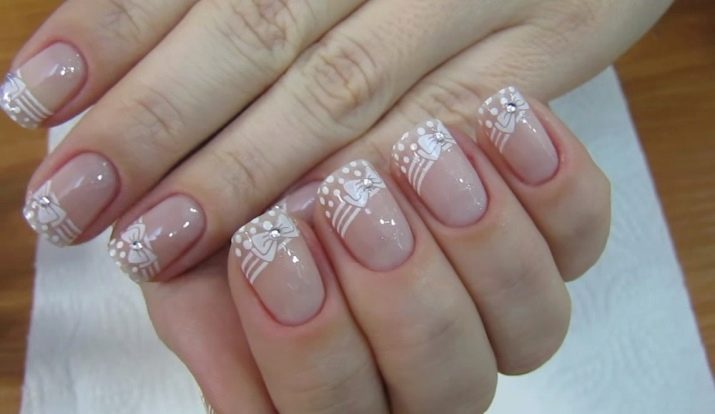
Slider design
Another solution that allows you to beat the lack of experience in nail art, are island or application sliders. Water stickers on a transparent base are convenient to use, such a jacket looks incredibly gentle and beautiful. It doesn’t take so much time to create the right design as tedious alignment of the smile lines.
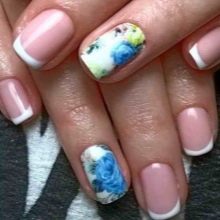
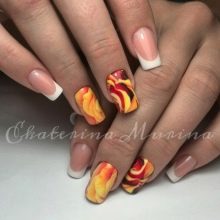
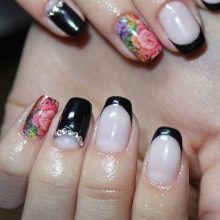
Fimo
This material is used for creative jacket.This decor is a variety of elements, cut into a thin layer of oblong sticks. These are a variety of stars, fruits, berries, which are simply glued in the area of overgrown nail plates. The decor is voluminous, and therefore it is impossible to call such a manicure comfortable in everyday life. However, Fimo can be used in aqua design by sealing on top with several layers of modeling tools.
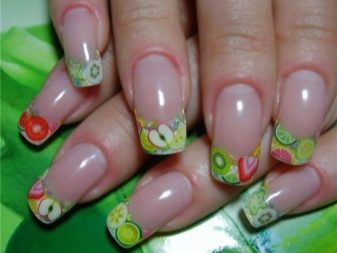
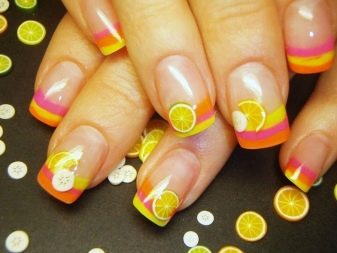
Necessary tools and materials
Depending on the variant taken as a basis, the type of tools and the raw materials used for design may differ. Let's take as a basis the traditional technique, from which in the future it will be possible to build on and improve the design with various decor. And it is also important to first determine the type of manicure, because it can be ordinary or hardware.
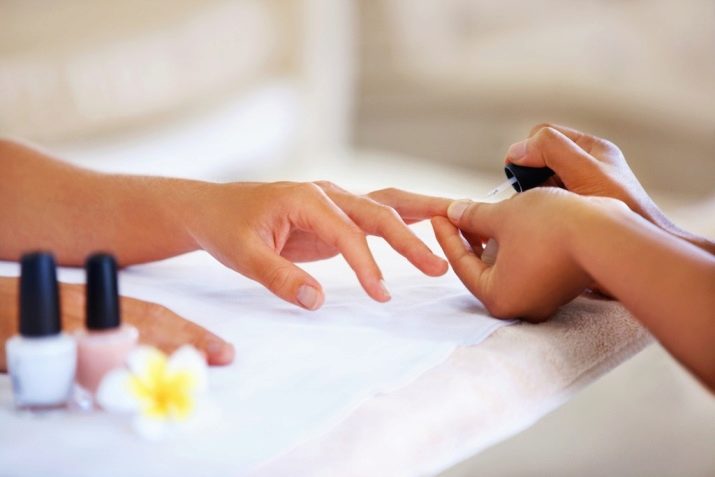
As for working with the device, this method is more convenient and less traumatic for the nails and the skin around them. If there is no apparatus at home, and a woman is just starting to get acquainted with nail art, you can use the basic set for manicure: manicure scissors, a nail file, a pusher, tweezers.
Also for work you will need:
- rubber hoof;
- manicure wipes;
- dehydrator;
- soft polisher (buff);
- drying lamp for nails of the required power;
- base material;
- finishing agent;
- pigmented varnish for the background;
- contrast pigment for a smile.

If you plan to complete the design on accent nails, prepare the decor conceived by the design. When dots are needed for decoration, but not, you can use a regular wooden toothpick.
Nail and cuticle preparation
Before starting the preparation, the nails are treated with an antiseptic. After that, the file gives the free edge of the nail plates the desired shape. At the same time, round-trip movements are strictly not allowed: all conditions are created for crumbling and further injury to the nails. In addition, two different directions of the file can cause manicure detachments.
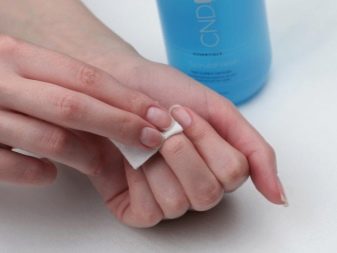
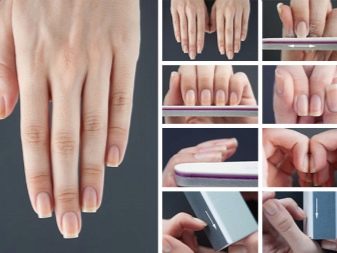
After that, a special tool for removing the cuticle is applied to the side rollers and the cuticle. It will help soften the skin and prepare it for faster and painless removal. After the product is applied to all 5 nails, the time comes for the most pleasant step of hygienic manicure. The hand is lowered into a bath of warm water (water temperature should be at least 30–34 ° C). The hand should be in the water for about 3-4 minutes. After the required time has elapsed, the fingers are wiped and proceed to manicure. Using a scapula-pusher, the cuticle and skin are pushed away on the sides. At the same time, you can not press the tool too hard so as not to injure either the skin or the nail.
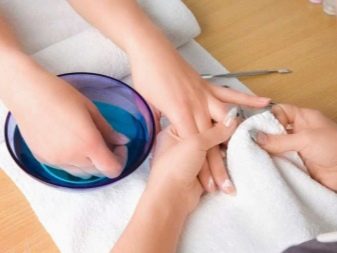

Next, take tweezers or a cuticle and cut off all the excess and keratinized around the nail plate. It is important to keep the tool at one angle and make sure that the cutting does not turn out intermittently. If everything is done correctly, then you can prevent the appearance of burrs in the future. After you go with tweezers, you should take a pusher or an orange stick and clean the pterygium. Before this, the stick must be wet in water. Walk along the contour of the nail when scrubbing pterygium carefully. This stage will allow you to assess the quality of the work performed by the tweezers: to understand how well you cleaned the excess skin. If, when passing through the contour with an orange stick, the remains of the skin are found, take a cuticle and clean up what was not cut off immediately.
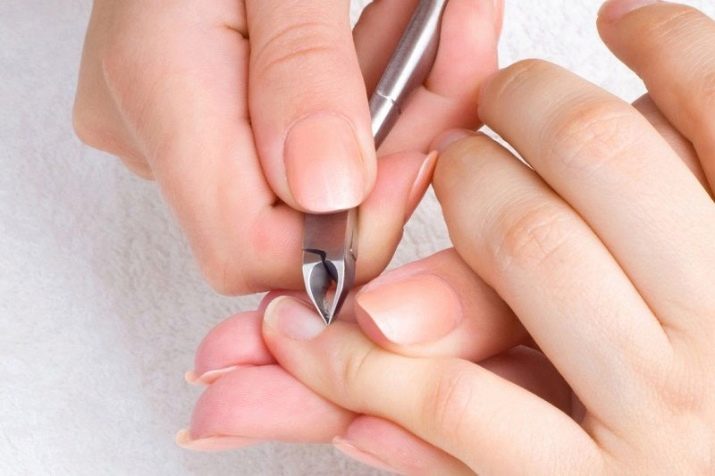
The procedure is performed on each nail. After that, special cuticle oil is applied to the skin treatment sites. It is at this stage that the trimmed manicure ends.
In order not to hurt the skin, you can take note of several tips from the masters in the field of nail service. For example, skin injury can be attributed to improper movements of the cuticle or nail scissors. You can not do it jerky, and even raise the tool up. To remove the cuticle should be movements along the cutting skin.
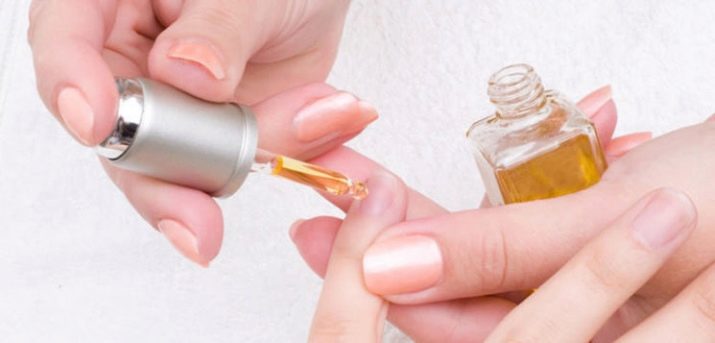
In order to minimize the risk of skin injury at this stage and not to cut off excess, you need to slightly pull the skin at the cutting site. So it will be seen where the cut ends, and the base line will not be torn. We must not forget that before trimming the larger side of the pusher, the skin at the base of the nail is pushed back and only then lifted. As for pterygium, it can also be cut with the sharp edge of a pusher. In this case, you do not need to deepen the tool too far under the nail. The injured skin around the nail will ruin the appearance of the manicure, and at the same time the mood. In addition, nails that have undergone similar stress will be sick for a long time. You can start further work with nails just before painting them.

Step-by-step technique
To get a high-quality coating, you need to choose sharp and comfortable tools. It is important to remember to sanitize them. With the correct implementation of all stages, keeping a French manicure on the nails will be at least two weeks. One of the main reasons for its fragility may be insufficient drying of each layer. You should not reduce the time of the general work at its expense, because as a result, the coating can begin to chip in a couple of days. It is better, on the contrary, to add time for the last (sealing) layer.
It is not difficult to do a French manicure on prepared nails.
Whether in the cabin or at home, the technology will be unified. It’s not always convenient to do a manicure for yourself, and therefore it may require more time. If there is not enough information, you can refer to the video tutorials of professional nail service masters. In the lessons, many professionals step by step show the perfect execution technique, teach how to perform step by step correctly.
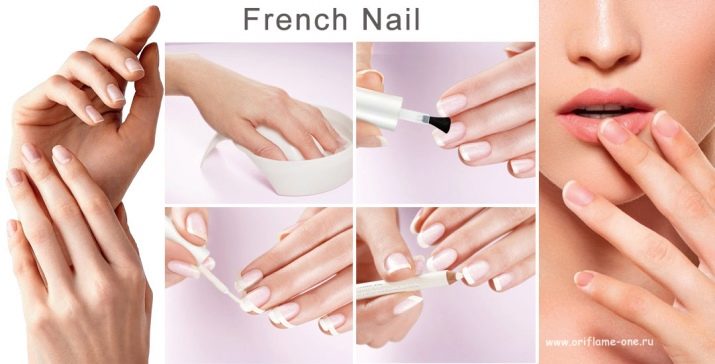
For work, they move the top, base, pigments, thin brush, stencils and a lamp, if necessary. You need to start with the preparation of the nail.
- Strengthening and removing gloss. At this stage, you need to remove the upper glossy layer from the nail plates. This is necessary so that all the layers applied in the future hold firmly and reliably. The longevity of the manicure will depend on this in the first place. Take a buff (soft rectangular grinder with fine grit) and remove the gloss with light movements. Next, use a dehydrator, degreasing the working layer and removing residues of sawdust. Now you can proceed to a decorative manicure or strengthen your nails. The strengthening process is necessary for thin and fragile nails. In addition, it will be useful for nail plates, which rarely rest between manicures.
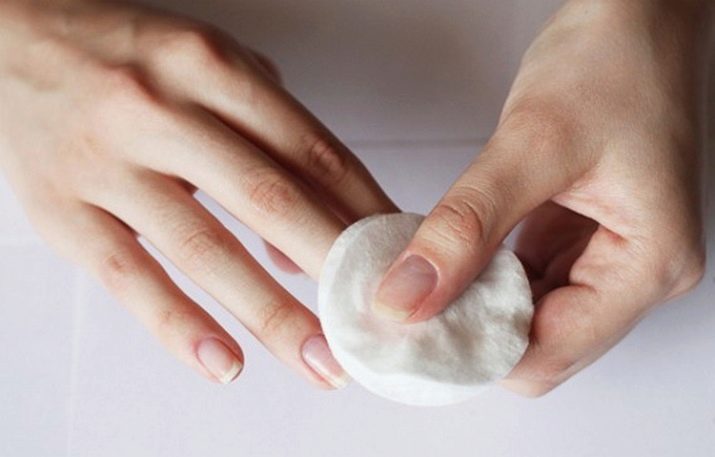
- Base coverage. Having removed the residual sawdust and oiliness, degreasing the surface of the nails, a layer of base material with a transparent texture is applied to them. Apply this material with a very thin layer, because the accuracy of work will depend on this (a dense layer of the product will flow over the cuticle and side rollers). The base is dried in a lamp, the drying time depends on the type of device (from 30 seconds to two minutes). It is important to consider that each layer applied will have to be dried when working with gel polish. And with each layer you need to go along the end of the nail, because the durability of the coating will depend on this. The base may remain sticky after drying, so you should try to avoid accidental touches.
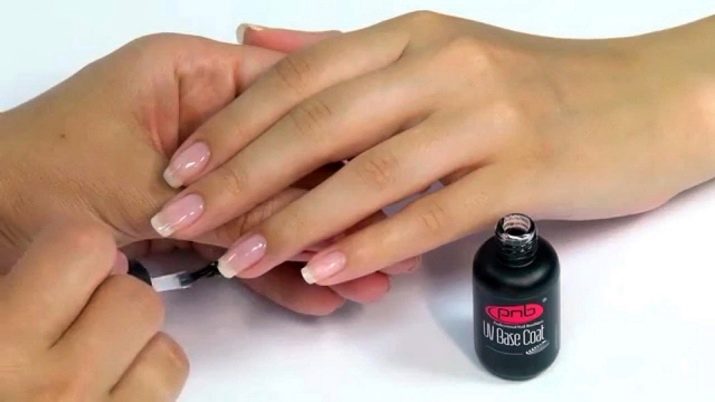
- Background. In the traditional technique, after the base layer, camouflage gel polish is taken with a maximum hit on the skin tone. Pigment is applied in two layers, with each of them dried in a lamp. So that the composition does not flow outside the skin and spreads evenly on the surface of the nail plate, you need to take a little pigment. In this case, it is undesirable to send the coating to the dryer immediately after application: you need to give the varnish the opportunity to spread over the plate, get rid of the strips.Since it is rarely possible for beginning masters to get neatly to the base of the nail, after the first layer of pigment is dried, they take a thin brush and paint on it the edge at the base of the nail. This will prevent the varnish from flowing, and will also make it possible to even out the pigmented layer, thereby giving the coating aesthetics. After brushing, the nail stains with a second layer of pigment. The varnish is dried in a lamp.
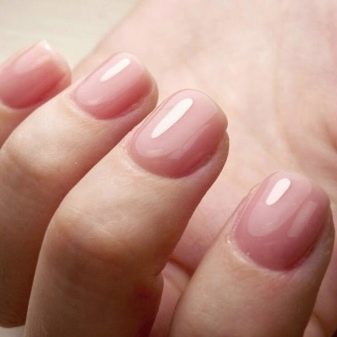
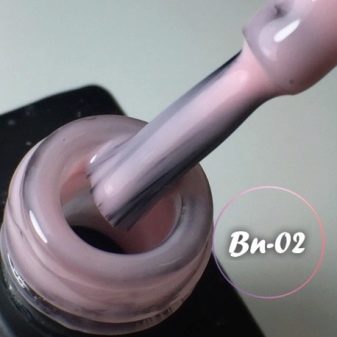
- Smile. A smile that will give the jacket a status is best applied with special acrylic paint or gel. For this, you can use contrasting gel polish to the main background. For beginners, it will be easier to use templates: depending on the type of stencil, this can be quick and easy. But if the stencil attached is uneven, the smile will also be uneven. If there is no fear of manual painting, take a brush and draw a white line first a thin line along the contour of the edge of the nail plate. Even with a professional, the hand can sometimes tremble, which will lead to the formation of a defect. In this case, you can use a special tool by dipping a brush in it to correct the line. If the work is slow, the drawn line may spread out a little.
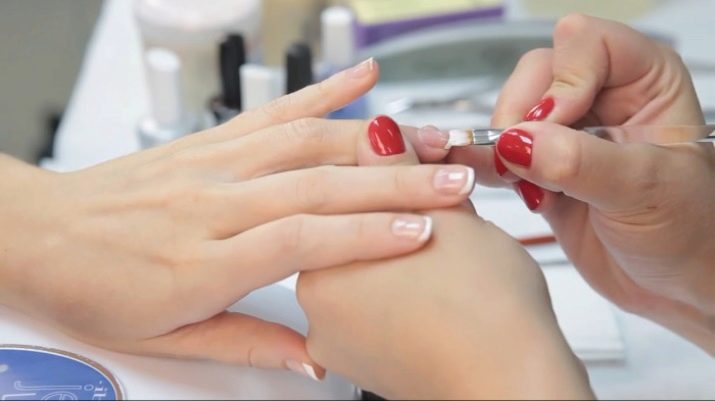
To prevent this, after drying the background gel polish, residual stickiness can be removed. Now you can safely display the desired line, trimming its width. So you can not worry that the material will flow and the line will spread out in width. To achieve the best accuracy in work, it is worth drying two nails in a lamp: the smile will definitely not spread.

- Sealing. After the smile is dried in the lamp, it is necessary to seal. To do this, apply a thin layer of top. Self-leveling material will smooth the background coating with a smile, making the step invisible to the smile line. However, if the smile initially turned out to be too thick, you need to use the buff, carefully adjusting the line of the smile in a delicate way. After that, you can apply another layer of top on top. Final drying will be the last stage of work.
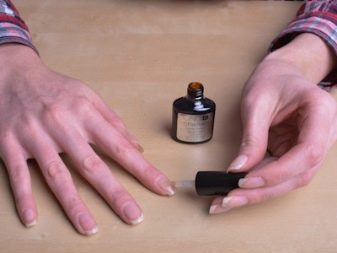
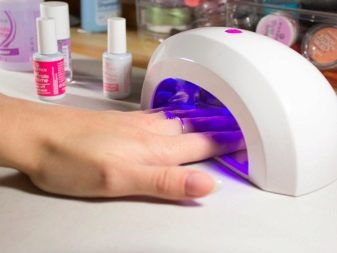
- Dressing. Having understood what constitutes a technique for performing French manicure, it can be diversified by leaving one or two nails under the design. You can not make a smile on them, but instead put a sticker on the accent, transfer the pattern using disposable stencils. The design with a pattern will also look beautiful. You can draw anything on such nails: a French manicure can be decorated even with a seasonal pattern. Today, this trend is quite popular.
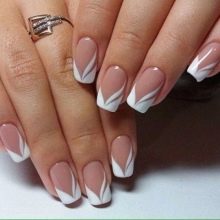
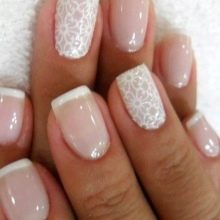
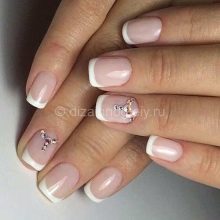
Do not cover up your smile on top with glitter varnish. This erases a clear contour, the coating may lose expressiveness. As for mother of pearl, the rub will look more weightless on a background basis. It is applied before sealing, a smile is made on top of it. The french jacket with pearl dust looks especially gentle; today it is considered the best material for creating a special background coating effect.
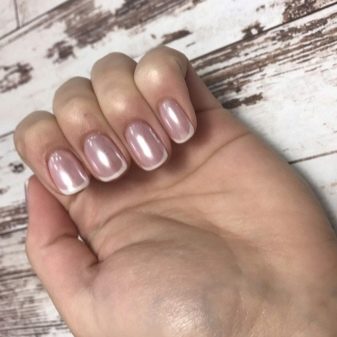

You can quickly and easily decorate French manicure with stickers or the so-called slider design. To do this, after applying the base material and pigment with their mandatory drying, an additional thin layer of the base is applied to the accent nail. The application picture is placed on a wet towel, wait 30 seconds, then remove it from the paper backing, apply to the nail on a layer of the non-dried base. The slider is leveled, then dried, strengthened with a base and sealed with a layer of top.
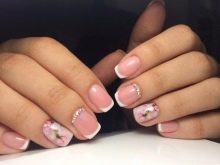
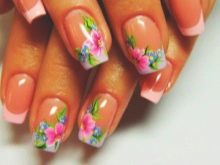
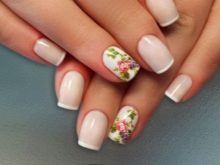
How to use strips?
Stencils and strips for french today can be used in different ways. They are glued, stepping back from the edge of the necessary distance. No need to press the template into the freshly applied and dried coating. Immediately after covering the prepared area, the strip or stencil is removed, since this will not work after drying.
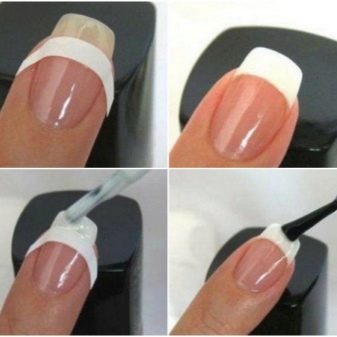
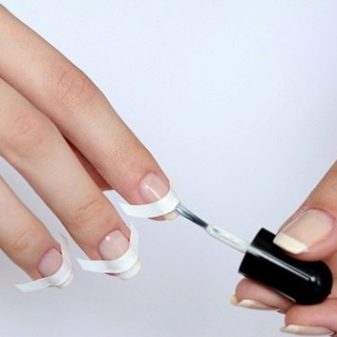
Strips are sold in ready-made sets, as well as rolls. Roll options give only a straight edge, which is not always convenient due to the characteristics of the nail plates.Sets are variable in form, it is convenient to work with them. Beginners can be advised to use, in addition to strips, a special silicone agent that protects the skin around the nails from varnish. Everything that will fall on the film can be removed, thereby increasing the accuracy of work.
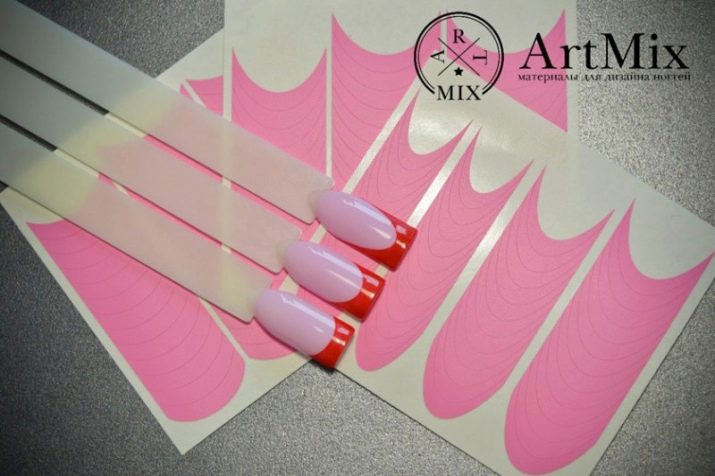
See how to make French manicure gel polish in the video below.
